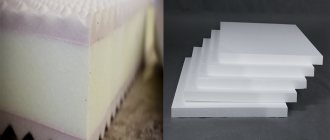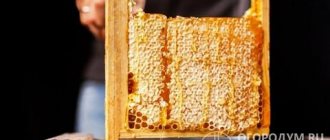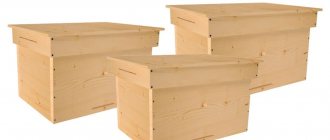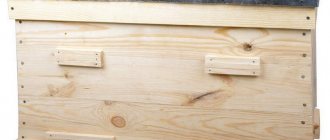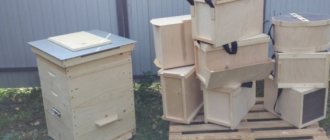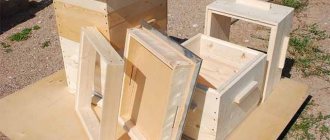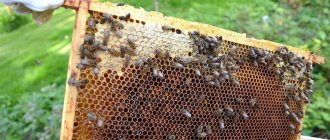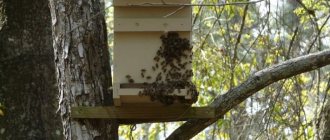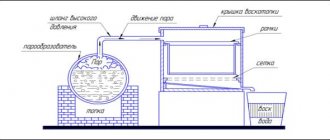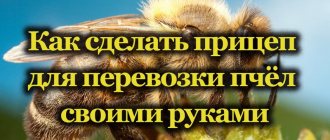Features of keeping bees in polystyrene foam hives
Wintering in multi-hull hives made of polystyrene foam does not involve bringing the hives into a special winter hive. Otherwise, there is a risk that the bees will become exhausted. When preparing families for cold weather, it is enough to move the boxes towards each other. This will keep you warm.
If there are wooden hives in the apiary, it is recommended to plant strong families in them. And leave the weakened layering in polyurethane foam boxes. With the approach of spring, the houses are placed in their places. It is worth noting that the activity of bees in polyurethane hives begins earlier than in wooden hives.
Basic requirements for homemade hives
1. The presence of a ventilation window in the bottom, covered with a fine-mesh metal mesh, and having dimensions of no less than 300 by 300 mm. This window is kept open all year round so that the bees do not get tired during the winter and do not start swarming in the summer from the stuffiness.
2.Use canvas, possibly polyethylene. Some homemade models are equipped with ventilation under the lid:
This is a universal roof that is used in two positions:
- mesh down - for ventilation in summer;
- with the mesh facing up - to ensure a solid ceiling in winter.
Interesting fact: There are recommendations to exclude any ventilation through the ceiling and maintain complete tightness here. It is not known for certain what they are based on.
3. Ensuring a tight fit of the body sections vertically - there should be no gaps that the bees will begin to insulate with propolis! Removing tightly glued parts with a chisel can damage them.
4. A small horizontal play is a mandatory design feature that allows you to carefully remove the body sections. When tearing off the body, you can carefully move it back and forth and left and right. For non-rebated models, no backlash is needed!
Features of beekeeping
In order not to be unfounded, here is a review from Czech beekeeper Petr Havlicek, who tested polyurethane foam hives for several years.
- a microclimate that is exceptional in its properties is created in a bee’s home - nests develop rapidly, starting in early spring;
- each hive rebuilds at least one body of foundation;
- all bee colonies in the multi-hull systems with 4-5 extensions used are quite strong and produce up to 90 kg of marketable honey per season;
- for the winter, the nests do not require reduction, which simplifies the maintenance of the apiary - there is no need to store dry matter, protecting it from moths;
- to prevent swarming, layering should be done in mid-May, reuniting separated families by winter;
- The quality of the hive is enhanced by the use of aluminum foil - it covers the structure from the inside and outside.
1.1Beehive bed area of application
The beehive is the most ancient, and therefore it is the most common type of hive. 20 years ago, every beekeeper worked with beehives at least once in his practice. It is believed that the sunbed hive is a good type of hive for a novice beekeeper who loves bees and wants to learn as much as possible about them and learn how to obtain high honey yields.
The sunbed hive is extremely effective in amateur stationary apiaries; nomadic beekeepers are not very fond of sunbed hives for their heaviness, but they note that when using beds with flat roofs, they can be loaded onto a two-story platform, so one platform becomes twice as large during transportation. more than hives of other designs.
The beehive is indispensable in queen-breeding and batch apiaries, and in apiaries specializing in the production of royal jelly.
The hive lounger is designed to contain bees of any breed that are found in Russia; the hive lounger is especially suitable for bees of the Caucasian breed, which are not very good at mastering extensions and magazines, but feel good in beehives.
1.2 Advantages of a beehive
The volume of the hive is sufficient for the development of a large colony strength, and for obtaining a large amount of marketable honey.
- A 24-frame hive allows you to easily place two bee colonies over the winter through a partition, and in a hive you can organize the wintering of the main bee colony and 1-2 layers or nuclei with spare queens, separating them from the main family with a partition. The main family and the cuttings or nuclei will mutually warm each other and will overwinter well.
- The sunbed hive allows, when caring for bees to prevent swarming, to organize layering in one hive and carry out other anti-swarm measures, while in riser hives either another hive or buildings are needed.
- In the summer, by partitioning a 24-frame hive with plywood partitions, one hive can contain 12 cores with spare mats or 6 four-frame layers.
- A well-made beehive is very warm, so in many apiaries beekeepers simply spend the winter in the wild.
- There are no problems with expanding the nest; if in the case of a stand-up hive with the installation of second buildings or magazine extensions, certain tricks are required to force the bees to master them, then in sunbed hives it is much easier to expand the nest.
- In beehives, bees pull foundation very well.
1.3 Disadvantages of the beehive
Among the disadvantages of the sun lounger hive, the following should be noted.
- As a rule, the hive bed is very heavy, so they prefer to use it in stationary apiaries. It should be noted that many beekeepers get around this drawback by using new materials (PPS, polyurethane foam instead of wood), and by the fact that the transportation of the hive is carried out by two people.
- It is impossible to carry out work with bodies in a hive; frame work with bees is required.
- The queen moves freely throughout the hive and therefore the brood can be smeared throughout all the frames. However, this drawback is easily eliminated when using a Hahnemann grid, when the nest is partitioned with a grid and the queen works only in one part of the hive, and the second part of the hive is used for honey collection or when using a Hahnemann grid and placing honey supers.
Beekeepers' opinion
The attitude towards polyurethane foam in the beekeeping environment, as well as towards any artificial material, is wary and ambiguous.
There are the most opposite opinions - from moderately positive to sharply negative. Bee hives made of polyurethane foam are considered a source of toxic emissions - the material emits them under the influence of sunlight, as well as as it wears out during use.
But laboratory tests do not show any impurities in commercial honey. To which opponents of polyurethane foam respond - laboratory technicians are not looking for what is needed in the samples to confirm the harmfulness of this material to bees and humans. After all, it is well known that polyurethane foam is not recommended for installation in residential premises in the same way as polystyrene foam or expanded polystyrene such as Penoplex.
All these are insulation materials for external installation on buildings, including residential ones, as well as thermal insulation of various communications and ventilation systems. And in hives made of polyurethane foam or expanded polystyrene, bees are forced to come into direct contact with the building material. It is not known for certain how exactly polyurethane foam affects the resulting bee products.
Another important point is the arrangement of proper ventilation. The PPU construction is in many ways reminiscent of a thermos - it does not “breathe”, which requires the installation of a mesh on the bottom of the hive.
But at the same time, you should not be overzealous with round tap holes in the buildings - unwanted drafts may arise. It is enough to have a lower entrance slot, ventilation in the bottom and lid. However, this also causes heated debate - each beekeeper acts at his own discretion based on his own experience of using polymer hives.
Many people are put off by the price. One Dadanovsky building will cost the owners an average of 1,110-1,250 rubles (that’s what the well-known Nizhegorodets on the market costs).
Basic rules for painting hives
Beekeepers' opinions
Most beekeepers who have tried hives made of EPS (extruded polystyrene foam) or PU foam come to the following opinion regarding their operation:
- With this design it is easy to increase the bee colony.
- In hot regions, this design helps avoid overheating of the family.
- Due to the fact that the surface is quite smooth, it is not easy to care for. But still, it is necessary to think about how best to clean the inner walls from adhering bee diarrhea and other sticky parts.
About the material
Polyurethane foam is used in industry and construction more widely than other types of foamed polymers due to its plasticity. Its structure resembles frozen foam. Consists of synthetic polymers filled with gas.
PU foam hives are assembled from a rigid version of this material - ready-made sheets or self-foaming compounds in the form of a fill.
- excellent waterproofing characteristics;
- good adhesion – adhesion is ensured at the molecular level;
- low permeability to steam;
- low thermal conductivity.
PU foam does not become moldy and does not attract rodents, ants and other apiary pests. It is light in weight - three Rutov cases with a wall thickness of 35 mm weigh 17 kilograms. Resistant to mechanical stress. Provides high-quality sound insulation.
The only drawbacks are:
- fear of ultraviolet rays - the material must be hidden from the sun;
- highly flammable - burns quickly, releasing toxic substances.
The main purpose of polyurethane foam, according to SNiP 23-02-2003, is to protect buildings from cold and heat loss. The most well-known variety in everyday life is polyurethane foam, consisting of one component. And the most widespread are two-component compositions (polyol plus polyisocyanate, the reaction requires water).
Design features of polyurethane foam hives Nizhny Novgorod
In Russia, hives can also be made of artificial synthetic material - polyurethane foam. This design has long been valued in Sweden, Germany, Finland, and Poland.
Russian polyurethane foam hive Nizhny Novgorod, manufactured using molds, is not exposed to acid, alkali, salt, or paints. The PU hive does not require additional painting; it only needs to be primed at the molding stage. You can paint the hive with various paints (even with solvents) if desired. Beehives made of polyurethane foam are not subject to destruction by rodents.
The design of Nizhny Novgorod is not cellular. If dropped, the housing with frames may break at the joints. It has low thermal conductivity, which allows bees to feel comfortable in the cold season.
The Nizhny Novgorod polyurethane foam hive is made from environmentally friendly material, for which a sanitary certificate is given. The manufacturer pays attention to all shortcomings. All structural elements are solid. The polyurethane foam body is rigid, durable, and does not collapse over time.
All elements are connected using seam joints, which ensure strength and reliability. The Nizhegorodets hive provides for a backlash horizontally located between the housings. This way you can quickly separate the polished structure.
Beehives made of polyurethane foam are characterized by increased density. There is no need to place inserts under the frames. There are elongated handles on the sides for the beekeeper’s convenience when lifting the hive using an apilift, which is reliable and safe.
It is important to choose a mesh bottom complete with a sliding full-fledged tap hole. The PU hive can be painted with different paints. For technological purposes, when making a hive using molds, an anti-adhesive lubricant is used, so the polyurethane foam does not stick to the mold. Acrylic paint is not suitable in this case, as it often comes off in whole pieces. Afterwards, fuzzy edges and blurred edges appear.
However, sometimes wax may remain on some structural parts of the hive after production. The manufacturer takes this into account and uses sandpaper to burn the wax in the sun.
If you decide to make a polyurethane hive using molds, you must take into account all the nuances. This is the only way you will get a lightweight, durable, reliable, comfortable design. In Russia, such a hive has just begun to become popular; abroad it has long been valued in beekeeping. During production, it is necessary to rely on the experience of beekeepers from different countries.
When making a polyurethane foam hive with your own hands, be sure to use high-quality molds. This design is distinguished by its thermal insulation and waterproofing.
The uniqueness of polyurethane foam hives
Polyurethane foam was synthesized in 1937 by German scientists. This is the name given to a group of gas-filled polyurethane-based plastics. Polyurethane foam is widely used in construction, for example, for insulation, heat and sound insulation, or as a sealant (spray foam), in everyday life, and in industry. This is a very light, durable material, characterized by low thermal conductivity and vapor permeability and good adhesion to other materials. In foreign beekeeping, this material has been used for the production of hives since the 60s of the last century. Domestic beekeepers adopted this technology not so long ago, having seen from their own experience its many advantages and learned about its disadvantages.
Advantages and disadvantages of this raw material
You can make hives made of polyurethane foam or polyurethane foam with your own hands. These designs have many advantages:
- easy transportation;
- have thermal insulation properties;
- in such hives there is no noise transmission into the structure;
- care is very simple;
- polyurethane foam does not absorb moisture;
- parts can be swapped;
- the process of installation and dismantling is quite simple and understandable;
- hives made of polyurethane foam intended for bees are not subject to rotting or corrosion;
- long period of use;
- In such hives, bees do not require additional insulation.
Each beekeeper has the opportunity to assemble hives from polyurethane foam for his bees with his own hands if he prepares all the necessary materials and a drawing on which all the parameters and measurements will be noted.
In addition to the advantages, hives made of materials such as polyurethane foam have some disadvantages:
- very high degree of ignition, flammability;
- if there is no normal ventilation in the hives, then moisture will drain to the bottom;
- no air flow is provided.
How to pump out honey correctly: equipment, extraction, benefits
As for the cost, such bee hives are much more expensive than those made from other artificial materials. This is due to the fact that polyurethane foam has many advantages, the main of which are long-term operation and strength.
Video: Classic hives Dadan
A large audience of beekeepers like double-hulled hives for bees. The beauty is that you can “charge” them in advance. They are swapped, forcing the bees to collect nectar more actively. As you understand, remarkable male strength is welcomed here. Not everyone can handle such heavy lifting. You can't do it without an assistant. It’s nice that they are content with the only pitching at the end of the season. Not very suitable for wandering. But with proper care, it is great for wintering in the wild and in the open air. They are suitable for industrial plants. This is facilitated by the high frame. There is enough food for a long time.
Polyurethane structures
A hive made from a material such as polyurethane is distinguished by its extraordinary lightness, high quality and extraordinary strength.
Such insect housing contains the following components:
- bottom equipped with anti-mite galvanized mesh;
- pallet made of plexiglass, galvanized sheet, plywood or MDF;
- main body;
- cover with two levels of adjustment;
- a frame that will allow you to breed two queens.
All components of the case are assembled using special screws, but it is advisable to coat the joint areas with appropriate glue. This type of material, such as polyurethane, deteriorates when directly exposed to sunlight, so it is painted. The construction made of polyurethane foam has a significant drawback, which is associated with the short period of its use, namely, no more than five years. For this reason, the cost of such bee hives is much lower than others.
These structures are made using environmentally friendly material that has a sanitary certificate. Each element is fastened with a seam connection in accordance with the drawing, which increases the reliability and strength of the structure.
It is important to note the high density of the house. Handles are built on the sides. No inserts are placed under the frames. During the assembly process, as a rule, a mesh bottom is selected, which is equipped with a full-fledged sliding taphole.
If you take into account technological goals and use molds, you will need an anti-adhesive lubricant so that the raw materials do not stick to the molds.
When constructing such hives, do not use acrylic paint, as it comes off in pieces over time.
Pay attention to the quality and strength of the mold, as the quality of operation depends on this. In this way, you can provide reliable and effective waterproofing, as well as thermal insulation, which is important for the microclimate in bee houses.
If you want to purchase a similar model for your own apiary, choose the highest quality, harmless materials so as not to harm the inhabitants of these houses. It’s easy in such hives
Helping families in spring
Working with bees in beehives in spring and summer depends on the climatic conditions of a particular area.
If the main honey harvest occurs late - from the beginning to the end of July, it is more correct to maintain one bee colony with a full-fledged and well-sowing “queen”. By the beginning of honey collection, such a nest will occupy at least 20 hundred frames, subject to proper development.
During the early stages of the main honey collection, it is practiced to use helper families, staffed by overwintered “queens” or queens of this year.
The choice of queen in this case also completely depends on the climate, weather in the current year and the strength of the upcoming bribe:
- A strong spring honey flow requires old “queens” kept in the nuc behind a partition in the winter. They are used to replace unproductive females and correct queenless bee colonies, and unused nuclei are used to organize auxiliary nests.
- Young “queens” grown in the same year in layering are more suitable for summer honey collection.
Making beehives from polyurethane foam with your own hands at home
The process of making a hive at home.
The first step is to purchase pine boards. Their thickness must be at least 25 millimeters. It is important that they are dried as best as possible. Humidity should not exceed 15 percent.
Next, a pallet is made from the boards, the height of which should be 120 millimeters. There should be a grid in the floor. There should also be a rear debris removal door and a front slot caster. You should also take care of the liner to control the winter or summer passage.
The walls of the housings must be mounted using solid five-centimeter polyurethane foam covered with aluminum foil. All parts must be attached to the groove with polyurethane glue. A fold is selected separately for the upper cut, the height of which is approximately 10 millimeters. It is necessary for more reliable hanging of frames. All this is secured using a wooden insert, which should be installed in the grooves.
Next, two wooden straps in the form of an upper and lower frame are fixed to the outside of the hive body. The parts must be secured with glue, however, for greater reliability, it does not hurt to fix them with screws. Their length should not exceed 9 centimeters.
To ensure ventilation, small holes should be made in the corners of the structure. To prevent the bees from flying out, the holes can be covered with a net. There should be no free space under the frames, but above the frame it should be no more than 7 millimeters.
The last detail for the future hive is the lid. In order to make it, you need to stuff the shield onto the harness. It is also important to ensure that the cover is protected from rain and snow - for this it is best to use galvanized iron or any other protective materials.
Now the hive is ready and you can paint it. Making a hive according to this plan is quite easy, which is why all novice beekeepers use it.
Beehives made of polyurethane foam can be purchased ready-made. Today there are many models on the market from various ones, “Khimekselen”, “Bdzholyar”, “Nastusya”, “Khimtrast”, etc. It is also possible to make houses for bees with your own hands, starting from pouring the body.
You can quickly make a hive from polyurethane foam, but you will need certain knowledge and skills. It is important to prepare the necessary materials, tools and components for pouring, and also strictly follow the manufacturing instructions. The recommended temperature in the room where the hive is made is +18...+25°C.
Necessary materials and tools for work
To make a polyurethane foam house for bees you will need:
- molds for making the body;
- release agent;
- roller;
- 2 containers for filling components (0.5 l plastic buckets are suitable);
- a wooden spatula (kitchen) or trowel for cleaning out the remaining filler from the bottom;
- a special mixer or drill with an attachment for mixing paint and concrete;
- components for pouring polyurethane foam - polyol and isocyanate;
- kitchen scales for accurately measuring doses of components;
- screwdriver (screwdriver);
- self-tapping screws
How to properly install the second body on the hive
Step-by-step manufacturing instructions
It takes about 1.5 hours to make parts for the body of one hive. No additional drawings are required, since pouring using ready-made molds and assembling the body is quite simple.
To make the walls, roof and bottom, you need to perform the following steps:
- Coat the insides and projections of all molds well with release agent using a roller.
- Leave until the grease dries completely.
- Place the molds at a slight angle for better distribution of the potting mixture.
- Prepare the required number of components for pouring.
- Pour the isocyanate into the polyol and very quickly - within 10-20 seconds - mix the components until smooth with a drill attachment and pour into one of the molds.
- Cover the mold with a lid and secure with latches.
- Open the lid after 40–60 minutes.
- Fill the molds for the walls, roof and bottom in the same way. Before each subsequent pouring, the mold must be cooled to +45°C and below.
Assemble the hive body as follows:
- Connect the dovetail joints of the walls.
- Alternately connect each pair of upper and lower joints, central parts using self-tapping screws.
- Apply paint used for exterior use, such as ENAMEL, PF, etc., to the outer casing.
maintain an optimal climate for insects.
Independent production
Buying expanded polystyrene today will not be a problem. It can be bought at any building materials store. It is recommended to buy whole sheets rather than ready-made blanks. This will save money and cut the material yourself. By the way, cutting it is much easier than wood. To do this you will need a regular stationery knife. Glue and self-tapping screws are used as fastenings for the material. It is recommended to watch a video on how to make a hive from such material.
Dimensions for hives are usually always provided in drawings. In this regard, making a hive with your own hands will be much easier. But you can make hives from polystyrene foam using other sizes or create your own individual design that is suitable for a specific apiary.
Beekeeping includes many different types of bee houses, such as multi-hull hives, bed hives, single-hull hives and others. But when choosing a design, you should remember about comfort not only for insects, but also for the beekeeper.
Standard hive sizes:
- A hive with two bodies and extensions is manufactured to standard dimensions of 120 cm in height and 44.5 cm in width. The top cover is made a little wider, approximately 49 cm.
- Multi-body structures look like 126x37.5 cm. The lid can be made 52 cm.
- Single-hull structures: 67x72x56 cm.
- Bed hives: 64 cm in height, the width of the bottom is 87 cm, and the top is 92 cm. There should be a distance of 44 cm between the beds.
The photo shows all the main drawings with dimensions of the structures.
Blueprints!
Naturally, to make hives from polystyrene foam you will need to prepare tools and materials.
The material used is polystyrene foam about 5 cm, as well as a knife for cutting it, and a pen with a ruler to transfer the dimensions from the drawing. For connection, you can use any type of glue for the material used, as well as self-tapping screws 5 and 7 cm long. You will also need some corners and a metal mesh for bottom ventilation.
After preparing everything you need, you need to start manufacturing:
- You should look at the drawings and, using a pen or marker, transfer the dimensions to the sheet of material used.
- Next, using a knife you need to make cuts into the required parts. Everything should be done carefully, without haste, so as not to spoil the material.
- Next, you need to connect all the parts together using glue. First you need to glue the parts, and you need to lubricate both parts thoroughly; after gluing, it is recommended to secure all the parts with self-tapping screws. As reviews say, this will make the structure more durable.
- All parts must be combined so that there are no cracks or gaps that will further disturb the climate of the bees.
- Ventilation must be provided at the bottom. It is made from metal mesh. All the details on how to make beehives from polystyrene foam can be seen in the video.
Finally, it should be said that beekeeping in general is not an easy process and not every person can do such work. Therefore, to make work easier, it is better to use polystyrene foam hives, and reviews from the owners of such hives confirm this. Owners of such devices say that beehives for bees:
- They can complicate the production process due to their fragility.
- Cleaning should be done carefully, since after it, as a rule, the material is destroyed and it begins to crumble. In this regard, the finished product may lose its properties.
- A beehive made of such material does not protect the bees themselves and the honey from the penetration of rodents, which can easily chew through the material.
- Many beekeepers claim that the material is good because of its warmth.
Beekeeping in Europe has been using such structures for a long time and everyone is happy. In European countries, wood has not been used for a long time. Therefore, you should think about using such material in further bee breeding and honey production.
Using casting molds
If you use a self-foaming composition at home, you will need special forms for hives made of polyurethane foam. Two-component polyurethane foam is suitable for filling, for example, the Vladimur 3017-1p or Izolan system.
To prevent the polyurethane foam from sticking to the mold parts, the inside is treated with wax dissolved in gasoline. There is enough lubricant to assemble four housings. Then the processing is repeated. This is the advice of one of the folk craftsmen, whose video lesson is given at the end of the article.
To manufacture mold parts for a 10-frame Dadan, sheet metal is used, from which blanks of suitable height are cut using a grinder, a template, a ruler and clamps (for example, for a half-frame magazine, the height is 155 mm).
If the workpiece has bends, it is leveled with a hammer - straightened on a flat surface. Four parts are cut from the blanks for the inner and outer walls of the mold, which are temporarily grabbed for assembly - welded using a corner.
All joints are checked with an angle - maintained strictly at 90 degrees. The top and bottom of the mold are also welded from sheet iron. Holes for filling are drilled at the top.
The length of the upper and lower parts in the example given is: 500 mm front and rear walls, 410 mm sidewalls. Stops for the wall are 12 mm squares.
On the outside of the inner walls, 12 by 12 mm stops are welded under the hangers of the frames. Interwall space 40 mm.
Rings are also welded onto the inner walls from the inside of the structure to install the screed during pouring of the body. The top and bottom of the form are fastened with pins. Temporary clamps on the corners are cut off with a grinder
During the pouring process, the mounting holes are covered with plugs for a while.
Using a grinder allows you to save on cutting sheets with a guillotine. But for work you will need a supply of disks. On average, one cut (cutting out one workpiece in the form of a long sheet) takes 15 minutes.
Preparing parts
To create hives from polyurethane foam you will need a set number of components. These parts will allow the structure to fully function:
- body - the main part of the hive that protects the bee colony;
- bottom – 3 elements (protection against ticks, tray and bottom). For the mesh against small arthropods, use a die cut coated with zinc. Cells less than 3 mm in size;
- pallet - materials for manufacturing: plywood, PMMA (organic glass, plexiglass), galvanized sheets. The element is necessary to monitor the health of the bee colony. It accumulates death and mites, by which the beekeeper can judge the strength of the family and the degree of infestation. When moving, the pallet is removed;
- cover - a part to protect the bee house;
- hundred frames – made in standard sizes.
For cutting and assembling molds for casting beehives made from polyurethane foam, metal with a thickness of at least 6 mm is taken. Cutting is done using a grinder. The sheet metal is bolted to the prepared table. It is then carefully cut through, but not to its full thickness. This is necessary for less heating. After passing along the entire length, the finished form breaks off. The edges are cleaned.
How does the material affect the quality of honey?
Poles and Finns were the first to produce PPU and PPS hives. Later, domestic beekeepers began to resort to the material. Our beekeepers were wary of polyurethane foam. Because styrene accumulates in the body of insects and in bee products. However, there was no scientific confirmation of the harmfulness of the polyurethane foam material. Studies show that the accumulation of styrene is negligible, and they are safe for insects and honey products.
SES services do not inspect hives made from polyurethane foam. The examinations have proven that the material is completely safe, does not affect the quality of honey and can be used for the construction of apiaries.
What is better for bees: PPU or PPS?
PPU and EPS (expanded polystyrene) have long been discussed among thermal insulation manufacturers. Having carried out a comparative analysis as materials for building hives, I believe that polyurethane foam is superior to polypropylene foam in the following indicators:
- PPS has low physical and mechanical properties;
- exposed to chemical compounds;
- the decomposition temperature of EPS is lower (60 °C) than that of PUF (130 °C);
- the moisture content of the material is the cause of the appearance of mold and mildew inside the hive;
- The danger of PPS lies in its chemical structure. This polymer is subject to depolymerization with the release of a residual highly toxic substance, styrene. Even in small quantities it affects the heart, liver and mucous membranes.
